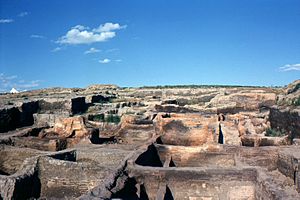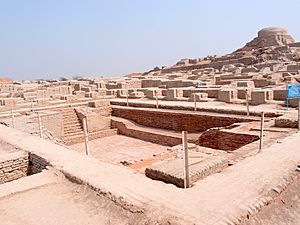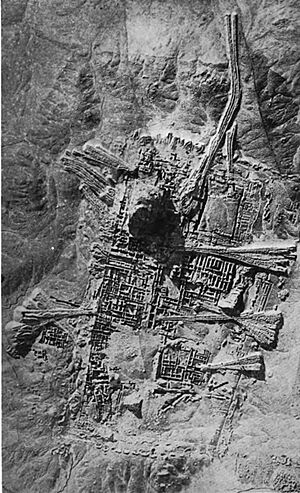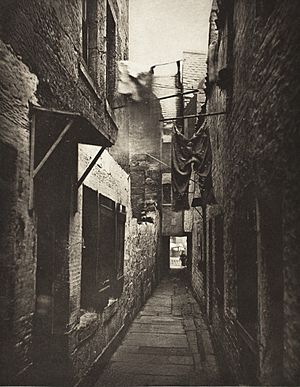History of cities facts for kids
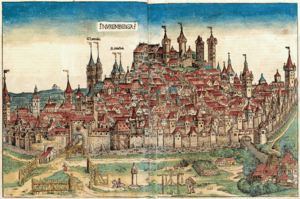
Cities are places where many people live close together. They have a very long history, though experts sometimes disagree on which really old settlements count as true cities. Living in a city can be great because it's easier to share ideas, find jobs, and get things you need. Some ancient cities even had cool features like running water and sewers! But living in a city can also mean higher costs, more pollution, and lots of traffic. Cities grow when the good things about people and businesses being close together are more important than the challenges.
Contents
How Cities Began
We don't have all the answers about how the first cities started. But some thinkers have ideas about what was needed for them to grow.
Small human settlements, like villages, existed thousands of years before cities. There were also large temporary camps used for religious events or by people who moved around a lot.
Many believe that cities first appeared after the Neolithic Revolution. This was a time when people started farming. Farming allowed more people to live in one place, which helped cities develop. When people could grow more food in a smaller area, it meant more people could live closer together and do things other than farming.
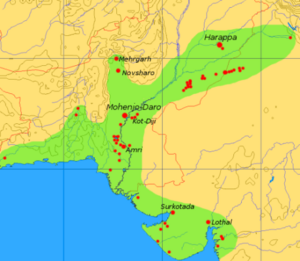
According to a historian named Vere Gordon Childe, for a settlement to be a city, it needed extra food and materials to trade. It also needed a fairly large population. If people were just hunting and gathering, they would need huge amounts of land to feed a big city, making trade very difficult.
Experts like Edward L. Glaeser say that cities grew because they made it easier and cheaper to move goods, people, and ideas around. He suggests that if a city doubles in size, workers might earn about 10% more! Even if the cost of living is higher, people still gain other benefits from city life.
Childe's 10 City Features
The first true cities are often seen as large settlements where people weren't just farmers. They started having special jobs, and trade, food storage, and power were all in one central place. In 1950, Gordon Childe listed ten things that often described ancient cities:
- They had a larger and denser population than normal villages.
- People had different jobs; not everyone grew their own food.
- People paid taxes to a ruler or a god.
- There were huge public buildings.
- The ruler supported those who didn't farm.
- They had ways of keeping records and practical science.
- They used a system of writing.
- They developed special art.
- They traded for and imported raw materials.
- They had skilled workers who weren't part of the local family groups.
These ideas help us understand ancient cities, even if not every city had all these features.
Ancient Times
The first complex human societies, known as first civilizations, appeared around 3000 BCE. They grew in river valleys like Mesopotamia, Minoan Crete, the Indus Valley Civilization, China, and Egypt. More food production led to more people and the rise of cities. People in places like Southwest Asia and Egypt started building cities and figuring out how to organize large states. Interestingly, ancient Egypt didn't seem to have many huge cities.
As ancient civilizations grew, empires formed, and trade increased. This led to even bigger capital cities and centers for business and industry. Famous examples include Alexandria, Antioch, Pataliputra (now Patna) in India, Chang'an (now Xi'an) in China, Carthage, and ancient Rome.
Early cities were very diverse. Some were political capitals with few people, others were busy trading hubs, and some were mainly religious centers. Not all cities had huge populations; some were important for their political or religious activities.
Mediterranean and Mesopotamia
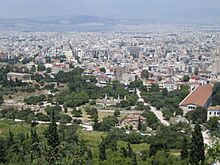
One of the earliest known cities is Çatalhöyük in southern Anatolia, which had about 10,000 people and existed from around 7400 BCE to 5200 BCE. Hunting, farming, and raising animals were all important there.
Eridu in modern-day Iraq was another very early city, existing from 5400 BCE to 600 BCE.
Ancient Mesopotamia, the land between the Tigris and Euphrates rivers in modern Iraq and Syria, had many cities by 3000 BCE. These cities were the foundation of the Sumerian and later cultures. Cities like Jericho, Uruk, Ur, Nineveh, and Babylon (famous from the Bible) have been found and explored. Others like Damascus and Jerusalem have been lived in continuously for thousands of years.
The Phoenician trading empire, around 1000 BC, had many cities stretching from Tyre, Sidon, and Byblos to Carthage in modern Tunisia and Cádiz in modern Spain.
In the early first millennium BCE, independent city-states in Greece began to thrive. They developed the idea of citizenship and became models of the free city, called the polis. The agora, a gathering place, was the center of sports, art, religion, and politics in the polis. These Greek city-states became very wealthy, leading to an amazing cultural boom in classical Greece. This included advances in architecture, plays, science, math, and philosophy, especially in Athens under a democratic government. A Greek planner named Hippodamus of Miletus (around 407 BCE) is sometimes called the "Father of City Planning" for his grid-like design of Miletus. This grid plan was used for many Greek and Roman cities later on.
The rise of Rome shifted power again. The city of Rome itself grew, and the Roman Empire formed. Rome founded many cities called coloniae. These cities usually had a grid pattern with north-south streets (cardines) and east-west streets (decumani). Rome built hundreds of cities and greatly influenced city development around the Mediterranean. They also developed sanitation, public housing, public buildings, and the forum (a public square).
Asia
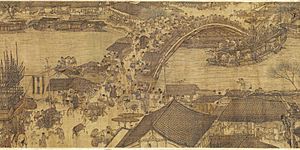
The Indus Valley civilization and ancient China also had their own important city traditions. Among the early cities, Mohenjo-daro in present-day Pakistan (from about 2600 BCE) was one of the largest. It had a population of 50,000 or more and a very advanced sanitation system. Also, Mehrgarh, an archaeological site from around 7000 BCE, might be one of the first cities in the world and where farming began in South Asia.
China's planned cities date back to around 2000 BCE. Early city-states used geomancy (a way of arranging things based on land features) to choose locations and plan cities. They often aligned their walls with the main compass directions. Cities were sometimes built as symbolic "mini-universes," with the center matching the pole star to show harmony between Earth and the heavens. In Chang'an, the imperial palace was in the north, facing south to catch the sun's light.
Sub-Saharan Africa
Farming was practiced in sub-Saharan Africa since 3000 BC. Because of this, cities could grow as places for non-farming activities, even before Arab cultures influenced city life. One of the oldest sites found so far is Jenné-Jeno in modern-day Mali, dating back to the third century BCE. Experts believe Jenné-Jeno was a city because it was a center for special goods and worked closely with the surrounding countryside, even if it didn't have huge buildings or a clear ruling class like some Western cities. Evidence suggests Jenné-Jeno traded with North Africa very early on. Other early African cities from around 500 CE include Awdaghust and Kumbi-Saleh (the old capital of Ghana).
Americas
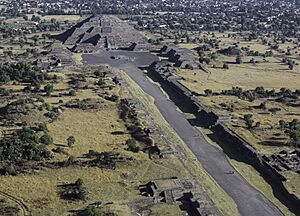
In the ancient Americas, early city traditions developed in the Andes mountains and Mesoamerica. In the Andes, the first cities grew in the Norte Chico civilization (also called Caral or Caral-Supe), Chavin, and Moche cultures. Later, major cities appeared in the Huari, Chimu, and Inca cultures. The Norte Chico civilization, the oldest known in the Americas, had as many as 30 major centers in what is now coastal Peru, thriving between 3000 BCE and 1800 BCE. Mesoamerica saw early cities rise in several areas, including the Preclassic Maya, the Zapotec of Oaxaca, and Teotihuacan in central Mexico. Later cultures like the Aztecs built on these older city traditions.
Teotihuacan, which thrived from 200 BCE to 750 CE, was the largest American city before Columbus arrived. It might have had 125,000 people by 200 CE. The city's grid plan started with the "Avenue of the Dead," connecting the Temple of the Feathered Serpent and the Pyramid of the Moon. Besides its ceremonial center, the city had 23 temple complexes and many workshops.
Middle Ages

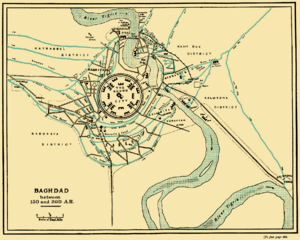
After the Fall of the Roman Empire, cities in the West first became more independent but then lost people and importance. Wealth shifted to Constantinople and to the growing Islamic civilization with its major cities like Baghdad, Cairo, and Córdoba.
From the 800s to the late 1100s, Constantinople, the capital of the Byzantine Empire, was the largest and wealthiest city in Europe, with nearly a million people. After many wars, the Ottoman Empire took control of many cities in the Mediterranean, including Constantinople in 1453.
During the European Middle Ages, a town was both a political place and a collection of houses. Living in a city often meant more freedom from the usual duties to a lord or community. A German saying was: "Stadtluft macht frei" ("City air makes you free"). Some cities in Europe even had their own laws, different from the countryside. In the Holy Roman Empire, some cities only answered to the emperor himself. New planned towns were built, like those by King Edward I in Wales and the bastides (fortified cities) in France.
By the 1200s and 1300s, some cities became powerful states. In Italy, medieval towns grew into city-states like the Republic of Venice and the Republic of Genoa. These cities, with tens of thousands of people, became incredibly rich by trading luxury goods like spices and silk from the East, as well as iron, timber, and even slaves. Venice even created the ghetto, a special neighborhood just for Jews. In Northern Europe, cities like Lübeck and Bruges formed the Hanseatic League for defense and trade.
Similar things happened elsewhere, like in Sakai, Japan, which had a lot of independence in the late Middle Ages.
In the first millennium CE, a city tradition developed in the Khmer region of Cambodia. Angkor grew into one of the largest cities in the world by area. It may have supported up to a million people through its advanced farming systems.
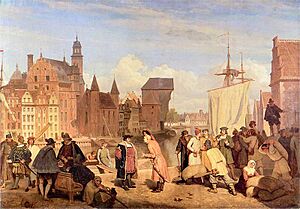
While the city-states of the Mediterranean and Baltic Sea became less important from the 1500s, Western Europe's larger capital cities grew again as trading centers, especially with the rise of Atlantic trade. By the early 1800s, London was the world's largest city with over a million people. Paris also became very big. New "bastion forts" were built to protect cities from stronger military weapons.
The Aztec city of Tenochtitlan in Mexico had an estimated 200,000 to 300,000 people when the Spanish arrived in 1519. During the Spanish colonization of the Americas, the old Roman idea of city planning was used a lot. New cities were founded in conquered lands, following specific laws for how they should be managed and built.
Most towns stayed small. In 1500, only about two dozen places in the world had more than 100,000 people. By 1700, there were fewer than forty, but this number jumped to 300 by 1900.
Industrial Revolution
The Industrial Revolution, starting in the late 1700s, led to huge urbanization (more people moving to cities). New opportunities in factories brought many people from farms to cities. England led the way, with London becoming the capital of a huge empire and other cities growing in places good for manufacturing. In the United States, from 1860 to 1910, railroads made transport cheaper, and large manufacturing centers grew, pulling people from rural areas.
Industrialized cities could be unhealthy places to live. This was due to overcrowding, dangers in factories, dirty water and air, poor sanitation, and diseases like typhoid and cholera. Factories and slums (poor, crowded areas) became common sights.
City Infrastructure
The 1800s saw the rise of public transportation, like horsebuses and later horse trams. By the late 1800s, electric urban rail transport (like trams and rapid transit) started to replace them. Later, buses and other motor vehicles joined in.
Street lights were rare until gas lighting became common in Europe in the early 1800s. Gas was also used for heating and cooking. From the 1880s, electrification began, making electricity the main energy source in cities, which it still is today.
Modern water supply networks also started to grow during the 1800s.
20th Century
Cities continued to grow throughout the 1900s, especially in developing countries like India, China, and Africa. This was due to more factories, efforts to encourage city growth, and other reasons.
Urban planning became a widespread and professional field. Around 1900, the "garden city" idea became popular. These were planned communities with homes and businesses, designed to be self-sufficient. Professional urban planners appeared to design cities and help manage them.
During the Great Depression of the 1930s, cities that relied on heavy industry were hit hard by unemployment. In the U.S., the number of people living in cities jumped from 40% to 80% between 1900 and 1990. Today, more than half the world's population lives in cities, and this number keeps growing, with about a million people moving to cities every day!
In the 1900s, car ownership steadily increased, leading to suburban sprawl (cities spreading out) and more highways. In the mid-1900s, people became more aware of ecology, leading to the environmental movement and a focus on sustainable development.
In the second half of the 1900s, many Western cities saw "deindustrialization" (factories closing down). This led to poverty, homelessness, and urban decay in once-rich cities. America's "Steel Belt" became a "Rust Belt," and cities like Detroit and Gary, Indiana started to shrink, going against the global trend of huge city growth. Meanwhile, under its Great Leap Forward and later plans, China has seen massive urbanization and industrialization, becoming the world's top manufacturer.
21st Century
There's a discussion about whether technology and instant communication will make cities less important, or if they will make big cities even more vital as centers of the "knowledge economy" (where ideas and information are key). Cities are now focusing on becoming "smart cities" that use technology to be more efficient in areas like business, innovation, environment, energy, and services for citizens. Some companies are even building brand new, planned cities from scratch in undeveloped areas.
- Gujarat International Finance Tec-City, India
- Nano City, India
- Putrajaya, Malaysia
- Bonifacio Global City, Philippines
- King Abdullah Economic City, Saudi Arabia
- Sejong City, South Korea
- Songdo International Business District, South Korea
- Dubai Waterfront, United Arab Emirates
- Dubai World Central, United Arab Emirates
- Masdar City, United Arab Emirates
See also
- History of water supply and sanitation
- List of oldest continuously inhabited cities


